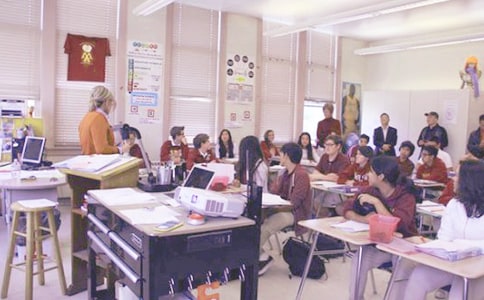- 相關推薦
Lesson 65教學設計實例
Lesson 65教學設計實例
Period: The First Period
Properties: Recorder, Pictures, Overhead projector
Teaching Aims:
1. Knowledge aims:
(1) Let the students know how to use adverbial clauses of time and condition.
(2) Learn modal auxiliary verb “must”.
2. Ability aims:
(1) Students can make sentences with “must” in their own words.
(2) Students can point which sentence are adverbial clauses of time and condition.
3. Emotion aim:
You must be more careful when you cross the road.
Language Focus: 1. adverbial clauses of time: when, before, after;
2. adverbial clauses of condition: if;
3. useful expressions: make a noise, stand in line, get on, get off.
Teaching Procedures:
a) Organizing the class
Greet the students and a student gives a duty report related to what’s going to be learned.
b) Revision
Dictation: It was my birthday yesterday. So I did my work early in the morning so that I was free for the day. My birthday was on Monday. I had a present for my birthday: it was a beautiful doll. I was twelve years old yesterday.
c) Leading-in
T: Write down “must” on the blackboard, then let the students listen to the teacher’s sentences.
1. We must study hard every day.
2. We must obey traffic rules.
3. We must be more careful when we cross the road.
T: Write down “mustn’t” on the blackboard, then make them listen to the following sentences.
1. We mustn’t make faces in class.
2. We mustn’t throw waste out of the window.
3. We mustn’t cross the road when the light is red.
d) Practise
T: Listen to the tape and then repeat it.
Look at Exercise one and two, let the students read the materials again, then check them.
T: Ask the students to make some sentences using “must” and “mustn’t”.
e) Presentation
T: Today we’ll learn adverbial clauses of time and condition. First let’s do the match exercises.
Part One:
1. If you drive too fast, you may have an accident.
2. If you make a lot of noise, you may disturb others.
3. If there is a lot of traffic, you must wait.
4. If the traffic light is red, you must stop.
5. If you are mot careful, a car may hit you.
Part Two:
1. When many passengers are waiting for a bus, you must stand in the line and wait for your turn.
2. When you get on the bus, you must buy a ticket.
3. When you get off the bus, you must look left and right.
4. When you are in the UK, you have to drive on the left.
5. Before you cross the street, you mustn’t push others.
f) Practise
Part One: the adverbial clause of condition: if
1. If he comes back, he may ring you up.
2. If you run too fast, you may fall.
3. If there are many mistakes in your exam papers, you must correct them carefully.
4. If you stuffy hard, you may catch up better not go out.
Part Two: the adverbial clauses of time: before, when, after
1. When you answer your teacher’s questions, you must stand up.
2. Before you go abroad, you must get a visa.
3. When you are about sixty years old, you may stop work.
4. After you sit down at the table in a restaurant, you may look at the menu first.
5. When you feel terrible, you must go to see the doctor.
Part Three: Ask the students to make some sentences. Then let them read them in class.
g) Language Points:
1. make a noise
(1) Don’t make a noise in class.
(2) When you make so much noise, you may disturb others.
2. stand in line
(1) When you wait for a bus, you should stand in line.
(2) When you visit a museum, you must stand in line.
3. get on/get off
(1) When you get on the bus, you should give seats to the old.
(2) When you get off the bus, you must be more careful.
h) Homework
1. Listen to the tape and recite Section Two.
2. Copy Exercise Three and read it.
3. Make ten sentences according to Section Three.
4. Do exercises of page 73.
i) Summary
用所給詞和詞組組成句子:
1. wants, to, she, be, an, artist
2. to study, science, his, went, brother, to England
3. made, it, me, feel, better
4. she, wash, her, mother, often, helps, clothes
Keys:
1. She wants to be an artist.
2. His brother went to England to study science.
3. It made me feel better.
4. She often helps her mother wash clothes.
【Lesson 65教學設計實例】相關文章:
Mainly revision Lesson 78教學設計04-02
四下 Unit 5 Free Time Lesson 1教學設計09-25
履歷的實例08-15
實例教學法在高中化學教學中的應用08-23
高中英語教學比較教學法實例探析08-22
初中歷史學科研究性學習活動的設計實例論文05-31
校服設計教學設計06-07
外企招聘員工面試怪題實例08-17
《母雞》教學設計08-15